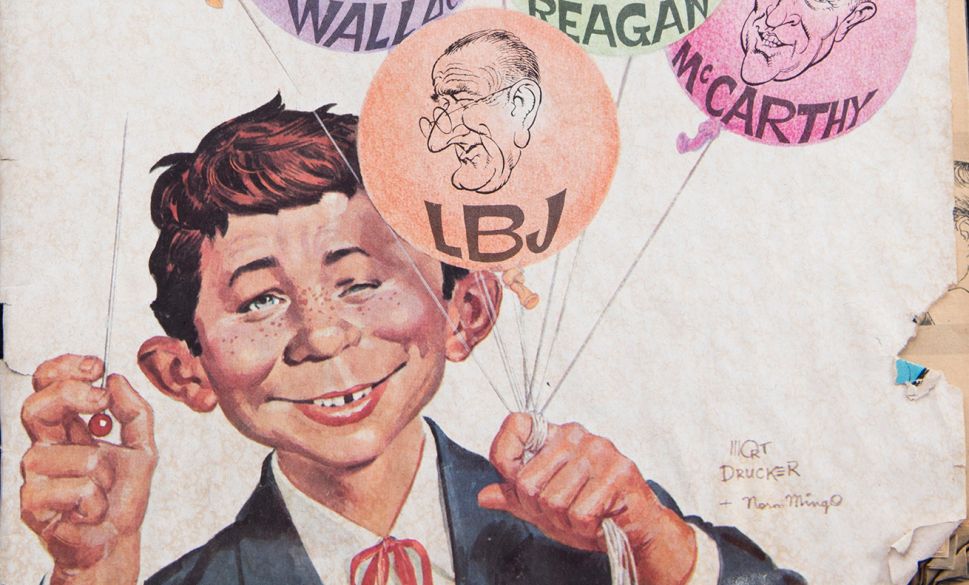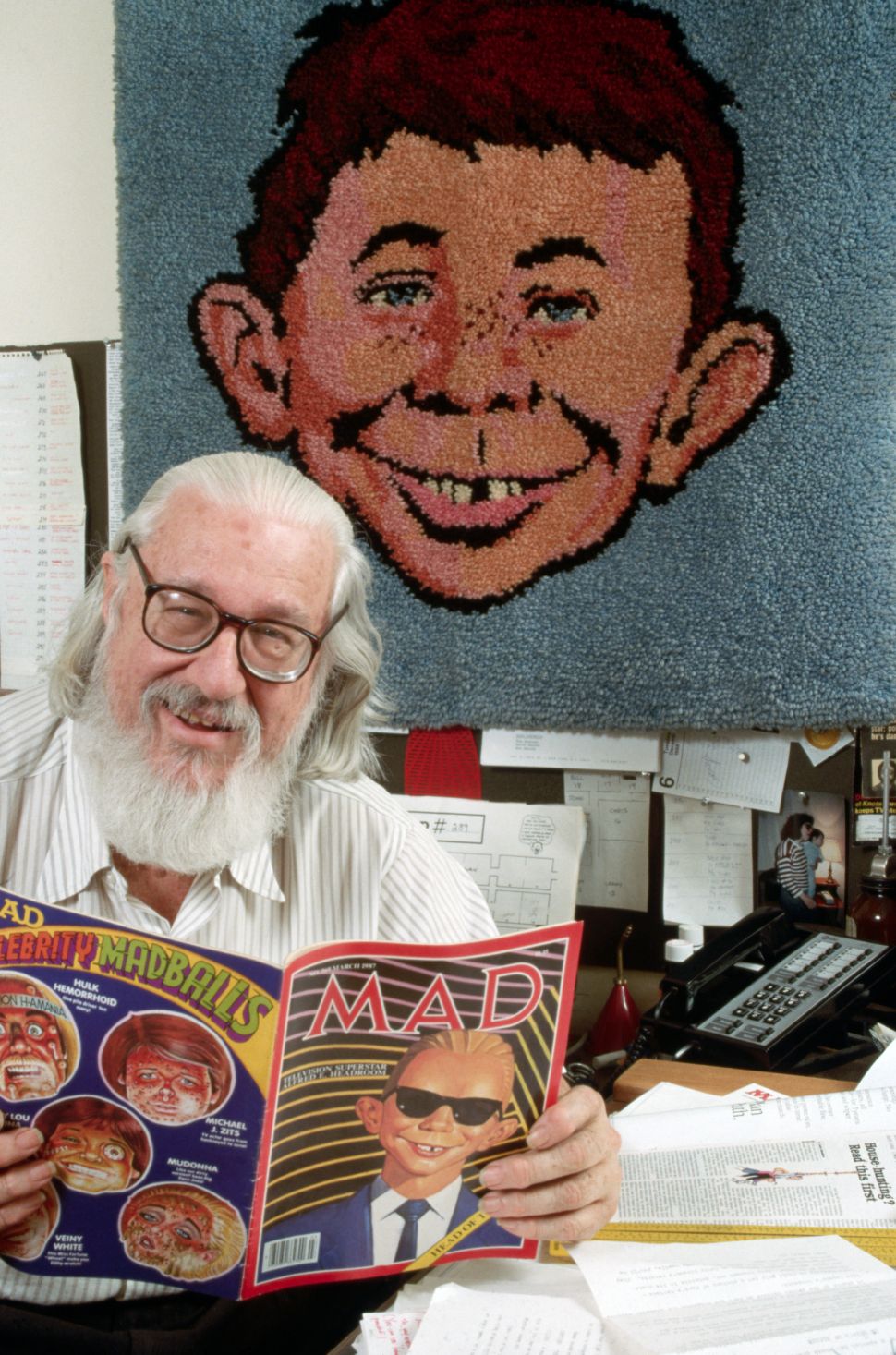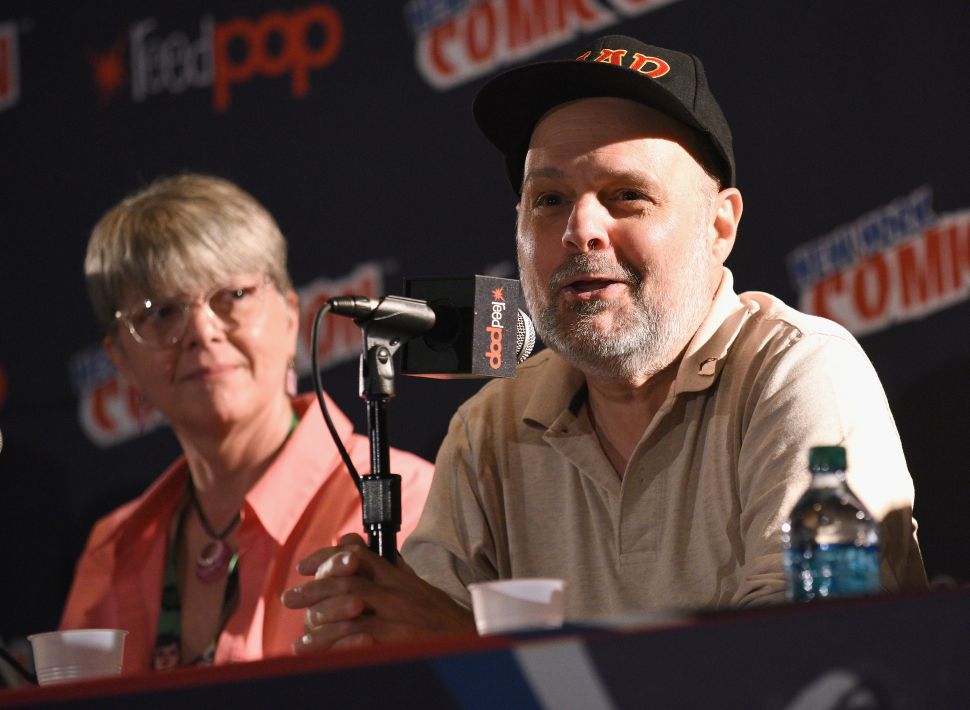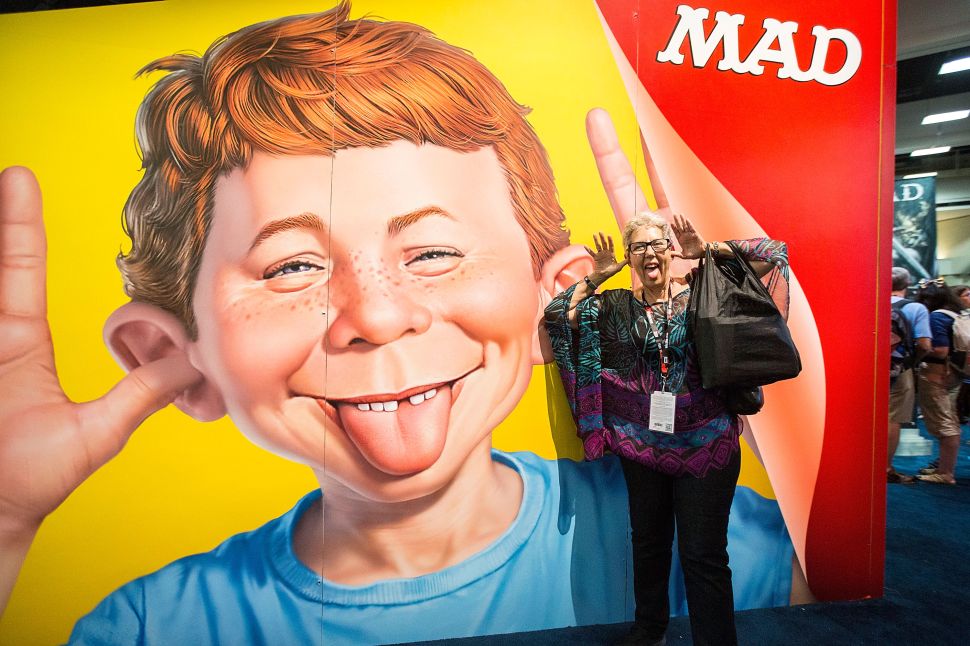Mad Magazine You Know Youre Really Grown Up When

"Mad spoke to me before I even realized it was speaking to me," said Joe Raiola, a man who spent 33 years as both a writer and editor for Mad magazine. "Kids generally understand that people are full of shit… Mad confirmed everything that I was thinking simply wouldn't say to anybody else: Everyone is full of shit—and yous tin can't trust anyone."
Growing up in Staten Isle, Raiola offset picked upwardly a copy of Mad when he was a x-year-old. Innately, he knew he had constitute a kindred spirit from the attitude and ethos of the mag'due south driving message: Always question authority.
SEE ALSO: Sense of humour Writers Are Perfecting Satire With 'Millennials of New York'
"That was illuminating for me," Raiola explained. "I digested the Mad vocalism."
Raiola was born in 1955, the same year that Mad became a mag (information technology started as comic book in 1952). He grew up on a steady satirical diet from "the usual gang of idiots"—Don Martin, "Spy vs. Spy," Dave Berg'south "The Lighter Side of," and especially the song parodies of Frank Jacobs, which paved the way to influencing Weird Al Yankovic.
Sadly, the iconic satire magazine is ending its 67-year print run in August. Gone. Vanished. No more. Only Mad will live on through how it influenced every comedic force that has ever thumbed its olfactory organ at authority, from The Simpsons and the Onion to Howard Stern, Judd Apatow and Stephen Colbert. Film critic Roger Ebert once explained how "Mad had broadened his horizons and opened his listen to the realities of movie-making." Manager Terry Gilliam wrote, "Mad became the Bible for me and my whole generation." Punk poet Patti Smith once stated, "Afterward Mad, drugs were nothing."
"The Mad voice is such a part of our civilization," said Raiola. "The magazine may die, merely the Mad voice certainly will not."
Raiola didn't initially ready out to work for Mad; he started his one-act career writing at National Lampoon mag. But in 1985, Fortuna took a spin for Raiola. After seeing an advert inThe Hamlet Vocalism that said Mad was looking for writers, he and his writing partner, Charlie Kadau, sent in some textile and were hired immediately past legendary Mad publisher William Gaines.
"We were in the correct identify at the right time," Raiola recalled. "Mad was a tough place to intermission into in those days."
Raiola will never forget his first meeting with Gaines, a mythical character who embodied everything Mad was about: "He said to united states, 'I hear from Nick and John [Mad editors] that you boys are very talented… I don't believe them.'" Gaines followed that up with, "I would similar to offer y'all a job, and I suggest to pay y'all as little every bit possible."
"Mad is the merely identify in America where if you work at that place and you lot matured, you got fired," stated Raiola. "I was never fired. In fact, I was promoted."
And working at the Mad offices—at 485 Madison Avenue—had such perks as 90-infinitesimal lunch breaks. ("Gaines was a firm believer that the sixty-minute tiffin interruption was non enough time," explained Raiola.) Though Gaines was known equally a cheapskate, he would flip the neb and pay for the entire Mad staff, even freelancers, to keep an annual trip abroad for everyone to bond together.
"It solidified Gaines as the accented icon, a archetype crazy publisher," said Raiola. "Who else would practise that? No 1. He was totally lovable, totally stubborn. Irrational. He was the unhealthiest person I've e'er met. And the happiest person I'd ever met. He lived life completely on his own terms."
What Raiola loved about Gaines was that he never permit Mad bow to the corporate force per unit area hoping to dictate the subversive content within its pages.
"No one told him what to practice because no 1 knew how he did what he did," said Raiola. "What he did was utterly extraordinary, and no one had ever seen anything like it."

Mad and Gaines created a cultural lexicon: "A magazine with a revolutionary satirical vocalization that sold two and a one-half 1000000 copies at its summit—with no advertizing," said Raiola. "Gaines was completely warped in his way of doing business and by whatsoever conventional standards, he should've failed miserably. Except he didn't."
One tin can only imagine what a comedic playground the Mad mag editorial meetings must have been like; ideas billowy off the walls like plates of blecch-induced spaghetti.
"You lot could non discover a less politically correct place than the Mad writers room," said Raiola. "Information technology was vulgar. It was over the top. We were continually coming up with jokes and material that we could never put in the mag. But that process would inevitably lead to abrupt textile. That was great in Mad. And that process really served us well."
"I don't know how likely a process like that would go over in the current historic period that nosotros live in, but boy, we had fun," added Raiola. "Nosotros certainly made each other laugh a lot."
Certain, Mad was often rude, tasteless and childish, but its comedy ideology was never to punch down at targets; the staff stayed away from what they called "victim humor."
"What fun is it making fun of people who have cancer or are sick or who accept died in a natural disaster?" said Raiola. "That was kind of similar our one in-business firm dominion."
Outright profanity was also never found inside the mag'southward pages. "I suppose nosotros could've used 'fucking shit' in Mad—if we really wanted to—but you know, that was an editorial choice that we made. We chose not to go, become at that place," Raiola explained.
Still, Mad had its fair share of controversies over the years. Raiola recalled the "Muhammad in a pancake" story, which involved the one, and only, time Muhammad appeared in the pages of Mad—in a slice Raiola wrote called: Other Religious Images and Nutrient Currently Available on Ebay.
"We had Muhammad in the pancake, and it was based on the Virgin Mary and the grilled cheese sandwich," Raiola explained, noting how the prophet was used every bit just i of many religious images found in nutrient.
The piece was published right around the time of the Danish Muhammad cartoon controversy that sparked protests and riots. After the story ran, the Mad offices got a telephone call from an aroused human in Pakistan, who didn't directly threaten the staff but was deeply upset and offended. "Man, that was not fun," Raiola recollected. "I mean we laughed, but we probably shouldn't take been laughing. You never thought going into the business concern of making Mad that y'all'd be taking your life in your hands."
Non entirely unrealistic, what truly impacted Mad's staff was the backwash of theCharlie Hebdo shooting, in which 12 people were killed after the French satirical magazine published controversial Muhammad cartoons. Mad's staff thought, "hey, that could've been us," which resulted in actress security brought in at their offices.
Mad even so managed to piss off other religious groups over the years. The Cosmic Church building took offense at a drawing that made commentary on the multi-million dollar lawsuits filed against kid-molesting priests.
"They accused Mad of a design of abuse—that was the actual phrase they used," said Raiola. "Tin you imagine that? The Catholic Church, the Catholic League accusing Mad of a blueprint of abuse."
The Catholic League issued a press release stating they were being repeatedly victimized past Mad in their portrayal of priests equally child molesters. "That always meant that nosotros were on the correct track," remarked Raiola.

Meanwhile, other entities were clamoring to be made fun of in the pages of Mad mag. Initially, motion picture studios didn't want their films to be parodied by Mad—until it became a sign of success to get the publication'southward send-up. Then, moving picture publicist would really approach Mad and ship its writers and editors press kits.
"Basically, they'd say, 'please make fun of our moving-picture show,'" recalled Raiola.
Zilch was off-limits in Mad'south earlier days, as the magazine would mock both Republicans and hippies.
"The voice of Mad in the '60s was a niggling fleck square in some fashion," explained Raiola. "It was square and unique at the same time."
The ethos of Mad was completely against and outspoken nigh the Vietnam war, as well as anti-Nixon, which was perfectly in-line with the counterculture. "But Mad was also anti-drug and that was not consistent with the counterculture at all," said Raiola.
Nonetheless, that didn't mean the '60s counterculture didn't love Mad.
In an iconic photo of Jimi Hendrix, he's getting his hair styled while reading a copy of Mad magazine, upshot #113 to be precise. The photo is and then endearing; I'd like to call up that when Hendrix played his rendition of The National Anthem at Woodstock, he was doing his Mad magazine interpretation of the vocal—thumbing his legendary olfactory organ at say-so.
"The Mad editors couldn't tell you much about Cream or Crosby Stills and Nash or the Strawberry Alarm Clock," said Raiola. "They were Tin Pan Alley guys. There were older guys."
Sure, simply Mad'south contributors were a crazy, unique agglomeration of interesting characters with diverse backgrounds.
Before joining Mad, cartoonist Don Martin, really designed the cover artwork for Miles Davis' 1953 album, Miles with Horns. Cuban cartoonist Antonio Prohías fled to Miami in 1960 in fright of being jailed past the Castro regime, who accused him of being a spy for the CIA. Prohías went on to make a legendary career out of his Fidel spy accusations with the cartoon, "Spy vs. Spy"—which was essentially about the futility and insanity of war.
"He was pissing off Castro," said Raiola. "Made his way to Florida, made his fashion to the Mad office and pitched 'Spy vs. Spy.'"
Another immigrant who made it big in the pages of Mad was cartoonist Sergio Aragonés, who, in 1962, fabricated the trek from Mexico to New York City in search of piece of work. Since he had a shaky command of English language, Aragonés asked that Prohías be present for his coming together at Mad, which proved to be a fault; Prohías knew even less English than he did.
Mad's craziest character, however, has to exist the magazine's mascot, Alfred E. Neuman. It was once rumored that the elephant-eared cover-boy was modeled after Prince Charles. In reality, information technology was taken from a 1910 ad, from Topeka, Kansas, for "Painless Romine," a dentist.

Perhaps one of the almost love and creative figures at Mad was Al Jaffee, who, since 1964, created the hilarious back cover fold-ins—designed as a response to Playboy's fold-out centerfolds. Jaffee, who is at present 98 years erstwhile, is based in New York City and would oftentimes pop past the Mad offices. Every bit recently as 2017, he would hand deliver each new monthly back encompass fold-in.
"There'd be an unveiling of the fold-in," said Raiola, "We e'er loved when Al came by. Al was the kind of guy who would get applause just for walking into a room."
With Trump now in the White House, it seems like this should be yet another golden era for Mad to thumb its olfactory organ at the powers that be—with some other strong battle cry to question authority.
"Mad was never more political and never more than politically sharp than in the 2016 campaign," said Raiola. "Rolling Rock called us the all-time political satire magazine in the state. This is a great fourth dimension for Mad humor."
So, what took down Mad in the end?
"Unfortunately, it's not a dandy time for printed sense of humour. Mad'south disappearing from newsstands. Correct," said Raiola. "Well, newsstands are disappearing…"
What does Raiola conclude well-nigh his 33 years working for Mad and its touch on on our cultural zeitgeist? "Mad is a mindset; it's a lens through which one sees the globe," he explained. "I had the proficient fortune to inherit the tradition, the voice, and assistance make information technology my own."
True, that'due south the lineage of what all the Mad editors did from the early days of Harvey Kurtzman and Al Feldstein and onward—steered by the destructive vision of crazed genius William Gaines.
"We were fortunate plenty to take the opportunity to receive this slap-up satiric, and uniquely American, phonation that emerged out of the McCarthy era," said Raiola. "Think almost how dour things were in the '50s, and Mad was built-in from that."
Raiola's years at Mad accept taught him to never end thumbing his olfactory organ at authority.
"I'll never grow out of it. It's reflexive as is at this point," he summarized. "It's been a fucking marvelous ride. It really has."

Pre-order Harmon Leon's latest volume, Tribespotting: Undercover Cult(ure) Stories, now. 
Source: https://observer.com/2019/07/mad-magazine-joe-raiola-reflections/
0 Response to "Mad Magazine You Know Youre Really Grown Up When"
Postar um comentário